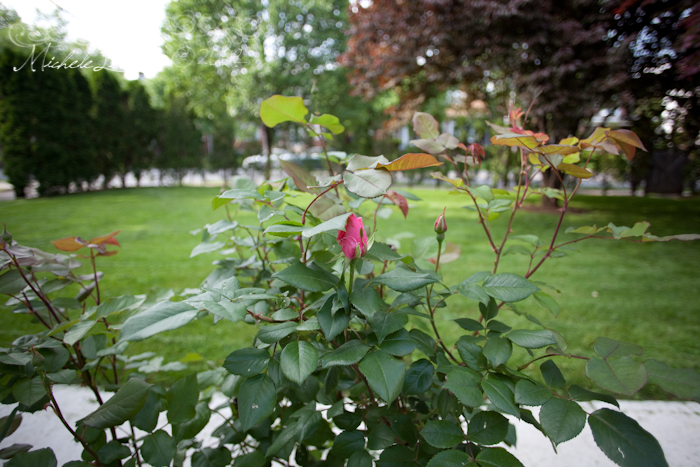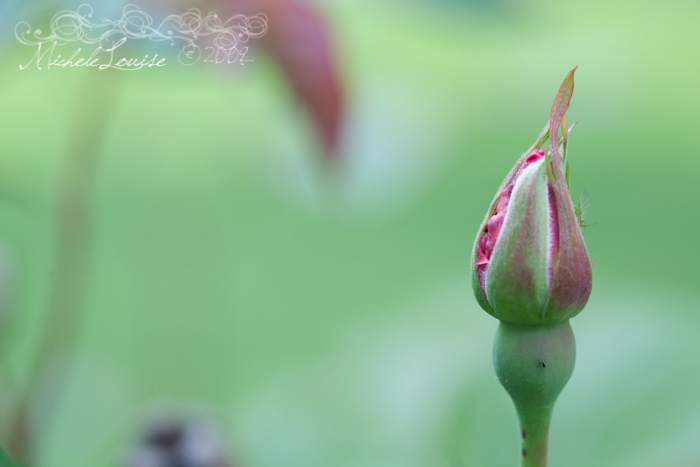Hopefully if you have read some of the articles I suggested in my first post you know by now what a shallow or deep depth of field is and that your aperture opening has a big impact on this. What you might not know yet is this isn't the only thing that impacts your DOF, nor is it the only way to get good bokeh. There are several other factors to consider and play with, mainly your focal length, focusing distance and for bokeh especially the distance between your subject and it's background. I thought it would be fun to go over each of those one at a time with example images. Another good way to understand the magintude of these changes if it interests you is to play with an online DOF calculator. This is a good one. You can enter in various combinations to see what the results might be before you go shoot and after. I have added the calculated information from below each image. All images shot with 5D Mark II.
Aperture:
Let's start with a review of aperture and how that impacts your DOF. The aperture (recorded as something like f/1.2, f/2.8, f/8, etc) designates how open the aperture of your lens is. The larger the number the smaller the opening (because it is a fraction) letting in less light, the smaller the number the larger the opening the more light allowed in. Now a larger number also means a deeper depth of field, and a smaller number means a shallower DOF. The easiest way to show this is with my 50mm 1.2 lens. So here is a shot at f/1.2 and one at f/8. Obviously I had to change other settings in these images to get the same exposure for each so there are other differences as well.

50mm, f/1.2, ISO 50, ss 1/500, focusing distance 1.5 ft
DOF Near Limit:1.49 ft, Far Limit:1.51 ft, Total:0.02ft

50mm, f/10, ISO 800, ss 1/125, focusing distance 1.5 ft
DOF Near Limit:1.43 ft, Far Limit:1.58 ft, Total:0.15ft
Focal Length
Aperture was pretty easy, focal length is a little bit different. I am not going to try to explain why (frankly I am not sure I know enough techincally about it to be able to anyway) but basically at the same aperture your DOF will be deeper with a wide angle lens versus a telephoto lens.

20mm, f/3.5, ISO 100, ss 1/125, focusing distance 1.5 ft
DOF Near Limit:1.35 ft, Far Limit:1.69 ft, Total:0.33ft (for some reason the online calculator I am using has f/3.4 and f/3.6 but not f/3.5, so I used f/3.4 for these calculations)

100mm, f/3.5, ISO 100, ss 1/125, focusing distance 1.5 ft
DOF Near Limit:1.49 ft, Far Limit:1.51 ft, Total:0.02ft

Standing in the same place as with the 20mm with 100mm, also obviously changes the composition, so I also backed up and took an image with the same amount of the rose bush in the frame
100mm, f/3.5, ISO 100, ss 1/125, focusing distance 5 ft
DOF Near Limit:4.93 ft, Far Limit:5.07 ft, Total:0.14ft
Focusing Distance:
This plays a big part in macro photography and is well worth understanding if that is a type of photography you are interested in. The closer the point you are focusing on to your sensor the narrower your DOF will be. Two shots with my 100mm f/2.8 macro both at f/4.5.

100mm, f/4.5, ISO 320, ss 1/100, focusing distance 1.3 ft
DOF Near Limit:1.29 ft, Far Limit:1.31 ft, Total:0.01ft

100mm, f/4.5, ISO 320, ss 1/100, focusing distance 2 ft
DOF Near Limit:1.99 ft, Far Limit:2.01 ft, Total:0.03ft (that doesn't sound like a big increase, but it tripled and in macro work that actually is a long distance.)
A great exercise to complete especially for macro work to help you get a handle on this one is to put your camera in aperture priority mode, start at your minimum focusing distance and go up through the aperture settings (f/2.8, f/4.5, f/5.6 etc) then back up and repeat. Ideally you would do this with your camera on a tripod so that slower shutter speeds at narrower apertures do not negatively impact your images.
Distance between subject and background:
Now this doesn't actually change your DOF at all, but it does change sort of the apparent DOF, and definitely impacts the bokeh you get in your image. If you have played around at all with the DOF calculator you will see that your DOF falls off as you travel away from the focus point, therefore the more distance between your subject and the background the less likely the background will fall in the in focus area. Examples here are again 100mm macro lens,

100mm, f/4.5, ISO 320, ss 1/100, focusing distance 1.5 ft
DOF Near Limit:1.49 ft, Far Limit:1.51 ft, Total:0.01ft

Here I just moved around the bush to a spot with more leaves right behind my subject flower.
100mm, f/4.5, ISO 320, ss 1/100, focusing distance 1.5 ft
DOF Near Limit:1.49 ft, Far Limit:1.51 ft, Total:0.01ft

No comments:
Post a Comment